Programmers - well most of them anyway - like speed. I'm not sure why that is. I guess because they always have the idea things can go faster if it's programmed smarter. Becomes a bit of an honorary thing... or an ego trip, depending on the programmer.
But most of the time, speed is simply a necessity, or even a demand. Speed can be a true bottleneck, for interoperability, for user experience or for other practical reasons. Slow software also has a high irritation factor. Research done by Microsoft shows that users will start to get irritated in a web browser or with regular software, if there's no response within five seconds.
Now what's five seconds?
To be honest, I think people are still quite patient with five seconds :-)
Of course 'not responding' and 'slow' are also two different things.
Anyway... I wasn't too happy with the processing speed of DNGMonochrome, but at first I couldn't figure out why some of the functions were executing like a snail. Then after concentrating on parts of the different algorithms, I was able to identify the main culprit.
And then it became fairly easy to turn it around into a faster version.
So 0.9.2 beta can be downloaded, with a speedier regular conversion, and more speed in the red and blue conversion. Although in those, phase 4 and 5 are still as slow as ever. I might be able to smarten that up too, but no promises.
Also in this version the Save dialog for Windows XP SP3 is fixed and should work now properly.
Still designated 'beta', feels more comfortable for now...
You can download this new version here.
Monday, July 23, 2012
M9Tether 2.2d released
Not so great timing, but I can't help it that Leica doesn't follow my schedule. :-)
So after releasing 2.2c, just a few days ago, there's now 2.2d.
The only difference being that 2.2d fully functions with the new Leica firmware (1.196) they brought out today (of course this version also still operates fully with 1.138, 1.162, 1.174 and 1.176).
I designed M9Tether under the assumption the PTP implementation might change with firmware updates, blocking some functionality for use with newer firmware, as a safeguard.
So far (after now four new firmware versions) that assumption turned out to be wrong.
Also in this firmware (1.196) nothing was fixed, changed or added where PTP is concerned and RAMDisk mode operates as it did under the previous firmware. I wasn't able to detect any changes (somehow a bit disappointing, seeing that the PTP implementation really could use some attention - I still notice at least two bugs and the options to change settings on the camera are still as limited as they always were).
You can download 2.2d here.
So after releasing 2.2c, just a few days ago, there's now 2.2d.
The only difference being that 2.2d fully functions with the new Leica firmware (1.196) they brought out today (of course this version also still operates fully with 1.138, 1.162, 1.174 and 1.176).
I designed M9Tether under the assumption the PTP implementation might change with firmware updates, blocking some functionality for use with newer firmware, as a safeguard.
So far (after now four new firmware versions) that assumption turned out to be wrong.
Also in this firmware (1.196) nothing was fixed, changed or added where PTP is concerned and RAMDisk mode operates as it did under the previous firmware. I wasn't able to detect any changes (somehow a bit disappointing, seeing that the PTP implementation really could use some attention - I still notice at least two bugs and the options to change settings on the camera are still as limited as they always were).
You can download 2.2d here.
Labels:
m9tether
Saturday, July 21, 2012
M9Tether 2.2c released
A very minor release with two small memory bugfixes.
The program still suffered from freezes on my Windows 7 64-bit, and after extensive attempts to find the cause, or to even confirm this was just a problem on 64-bit, I had hardly made any progress with this problem.
Technically it isn't a freeze by the way. What happens is that the PTP event system fails. It's unclear if that originates in the camera or in the middle layer on the PC. The signal 'photo ready' isn't sent anymore (or at least not received).
But then, if you change say the ISO setting on the camera (which also causes an event to fire), all the previous events come in one go.
It's not so much a freeze, more of a pile up, like they're quite literally stuck, waiting to be released.
Then after running some additional debugging tools, I did find two lines of code that might have been responsible. I say 'might', because the bug didn't show up always before the fix. It's one of those things... You could snap away ten times and then the eleventh time events would get stuck. And those numbers differed constantly. So testing if the bug is really gone is almost impossible. You can only confirm it's still there (when it happens again), but not really confirm it isn't there anymore (it might happen on your next shot). This is one of the most annoying type of bugs a programmer can run into. And seeing how I'm dealing here with an unstable PTP implementation on the camera, USB drivers, Windows PTP drivers, and then my own code, all working together in an asynchronous event driven system, it's almost impossible to find out what's causing this, without first spending hours on sniffing out the low level communication between camera and PC (which then is only helpful if you can actually quickly reproduce the bug).
But after this fix, and snapping away for a long time, I wasn't able to reproduce the freezes, so I have good hope.
You can download this release here.
The program still suffered from freezes on my Windows 7 64-bit, and after extensive attempts to find the cause, or to even confirm this was just a problem on 64-bit, I had hardly made any progress with this problem.
Technically it isn't a freeze by the way. What happens is that the PTP event system fails. It's unclear if that originates in the camera or in the middle layer on the PC. The signal 'photo ready' isn't sent anymore (or at least not received).
But then, if you change say the ISO setting on the camera (which also causes an event to fire), all the previous events come in one go.
It's not so much a freeze, more of a pile up, like they're quite literally stuck, waiting to be released.
Then after running some additional debugging tools, I did find two lines of code that might have been responsible. I say 'might', because the bug didn't show up always before the fix. It's one of those things... You could snap away ten times and then the eleventh time events would get stuck. And those numbers differed constantly. So testing if the bug is really gone is almost impossible. You can only confirm it's still there (when it happens again), but not really confirm it isn't there anymore (it might happen on your next shot). This is one of the most annoying type of bugs a programmer can run into. And seeing how I'm dealing here with an unstable PTP implementation on the camera, USB drivers, Windows PTP drivers, and then my own code, all working together in an asynchronous event driven system, it's almost impossible to find out what's causing this, without first spending hours on sniffing out the low level communication between camera and PC (which then is only helpful if you can actually quickly reproduce the bug).
But after this fix, and snapping away for a long time, I wasn't able to reproduce the freezes, so I have good hope.
You can download this release here.
Labels:
m9tether
Friday, July 20, 2012
Bandana Boys
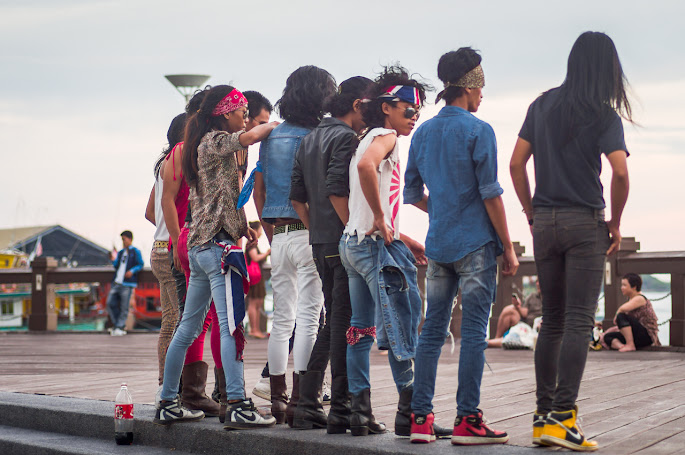 Kota Kinabalu, Sabah, Borneo, Malaysia, 1 May 2012
Kota Kinabalu, Sabah, Borneo, Malaysia, 1 May 2012 Click on photo for the full version...
Expression of individualism - through clothing or tattoos or piercings - is quite rare in Malaysia.
Tattoos and piercings are not done in Islam - that makes it rare within a population where 60 or 70% is Muslim. On Sabah (part of Borneo, Malaysia) a lot of people are Christian and/or from tribal descent (Kadazan - hi Jerome :-) - Rungus, Dusun, Murut etc. - I was told by a Sabahan there are something like 40 of these tribes on Sabah). And although tattoos were apparently not uncommon, within the different tribes, nowadays that practice is no more. Suffered away under pressure of former colonization, religion (Christianity also frowns upon anything that reeks of 'pagan') and let's say 'modernity'. The mindset also there is leaning towards conformism.
It means you don't see this kind of 'wilder' style a lot.
Ah Beng
There is of course the rather typical group of young Chinese in Kuala Lumpur, on the main land, referred to as 'ah beng', but that's more of a (rather big) group thing, They go about with chaotic, spiky dyed hair, baggy pants with a lot of chains - from belt to wallet and such - colorful shirts... you'll recognize them when you see them; the hair is always a give away. Just don't use the term 'ah beng' out loud to address someone, because it has a lot of negative connotations. I only associate the term with a certain style of clothing and hairdo, and I like how this group paints parts of the urban landscape of Kuala Lumpur with their flashy appearance, but for Malaysians and Singaporeans 'ah beng' is associated with poor upbringing, poor education, a low social status, a lack of language skills (not proficient in English or mixing Malay and English, the so called 'Manglish'), even with gangster activities. So you can imagine that it will be regarded insulting and derogatory if you address an individual as such.
I was quickly shushed down by friends who explained the term to me years ago, when I started using it too loudly on the streets of KL, not aware of its negative connotations. Basically it was taught by pointing... 'see, that's one' without a good explanation of the broader implications of the term - so I simply assumed it was about their colorful appearance - but I discovered those implications in time.
Mat Rempit
'Mat Rempit' is another such term, used mostly to describe young Malay street racers (on motorcycles).
It took me a while - after learning the term - to find out what - and especially 'who' was meant by it exactly. This term also carries an abundance of negative connotations: gangsterism, stolen motorcycles, dangerous behavior on the roads.
So I kept pointing at innocent motorcyclists asking friends 'is that a mat rempit?', being shushed again!
But I couldn't help it, because to me almost all these motorcyclists were exhibiting dangerous behavior!
Seriously... they're death defying, driving faster than cars - easily 110 - on what we over here would consider 'mopeds' - really small tires, with hardly any grip, nothing like a real 500cc or even a 125cc motorcycle, with no protective clothing, yes a helmet, barely, and sometimes two or three people on it.
Short pants, sandals, going at crazy speeds on the highway, smack in the middle of all the cars that aren't driving very neatly either, navigating from left to right, where ever there's space...
One moment of distraction, a car not noticing them - moving to their spot - and it's over.
I've fallen with a motorcycle once, fully dressed in protective clothing and I went down with only 30 kilometers per hour, but it took me at least a week to overcome all the bruises and my ankle was quite deeply cut, the one spot that wasn't protected too well and had dragged over the street under the motorcycle. Took months for the cut to fully heal. If you skid over the asphalt with 110 kilometers per hour, without any protective clothing, you're gonna be skinned alive, ending up like chicken filet. If you're not overrun by a car first.
To me they all seemed 'mat rempit'.
And after driving past a dead motorcyclist one day on a rainy dark evening, I wasn't surprised... I just wondered why I hadn't witnessed 'death on the highway' like that sooner.
Traffic was jammed due to his body on the road. The police directed the slow driving cars, like some improvised funeral procession, around him and his motorcycle, which was laying perhaps 10 meters in front of him. They didn't bother about the body - no medical attention - also an indication he was dead. Blood had run out on the wet asphalt from under his helmet, which was still on his head. It's strange how even in the dark you can differentiate between the structure of water and blood, without actually seeing the color; like an oil spill, shimmering in the headlights... not flowing anymore... still...
Young life gone, family distraught, and I wondered, as I always do when I see these young motorcyclists drive: aren't they aware of the risk? Or is it the age? That age where we all thought we were invincible and death was some weird thing that only happened to others?
But even up till now I've not been able to actually identify real 'mat rempit', so they remain somewhat elusive and a bit mysterious. I've also been thinking that maybe they don't really exist as a group and are just some kind of urban myth, cobbled up by suburban folks tired of some rascals.
'Those annoying mat rempit!' and a new term was born... who knows...
...
I'm not sure what kind of group this is, on the photo... none of the above anyway, but they might be 'related' to motorcycles.
Most noticeable is the foot wear, the big sunglasses, the bandanas, the leather jacket (remember it's around 30 degrees Celsius out there at that time of day) the rather tight print pants at the very
end, the leather pants in front of that, the bright red pants, the big black boots that seem too big for his small ankles, the cut off shirt...
The two on the right seem the most conformist, also standing a bit on the outside, detached from the others - with the one all the way on the right kinda shy with his thumbs in his pockets (the long hair is fairly normal on Sabah). If you would take away his yellow shoes (let's not do that) and replace them with sandals, he would drop out, since he's not wearing a bandana or anything 'outstandish'... maybe they're new in the group, not fully sure yet how to behave or dress, or maybe they're just along for the day, passengers, dressed up a bit for the occasion, or maybe the group is tolerant enough to accept any style of clothing...
And in some ways - seeing them as a group - it does fit into the tribal way of things I suppose. Not much different from your 'run of the mill' motor cycle groups - if that's their thing - you also have over here.
Although those might prefer beer to coke (notice the bottle, it's theirs).
They were posing in the sunset for a friend who took a photo...
I always try to join in on these group portraits (usually unnoticed) if I see one, and I like this photo a lot, but can't fully explain why. I guess because it talks to me (like I tried in this comment), not necessarily telling me any kind of truth though...
They might as well be bank employees out on a bachelor party...
I'm not sure what kind of group this is, on the photo... none of the above anyway, but they might be 'related' to motorcycles.
Most noticeable is the foot wear, the big sunglasses, the bandanas, the leather jacket (remember it's around 30 degrees Celsius out there at that time of day) the rather tight print pants at the very
end, the leather pants in front of that, the bright red pants, the big black boots that seem too big for his small ankles, the cut off shirt...
The two on the right seem the most conformist, also standing a bit on the outside, detached from the others - with the one all the way on the right kinda shy with his thumbs in his pockets (the long hair is fairly normal on Sabah). If you would take away his yellow shoes (let's not do that) and replace them with sandals, he would drop out, since he's not wearing a bandana or anything 'outstandish'... maybe they're new in the group, not fully sure yet how to behave or dress, or maybe they're just along for the day, passengers, dressed up a bit for the occasion, or maybe the group is tolerant enough to accept any style of clothing...
And in some ways - seeing them as a group - it does fit into the tribal way of things I suppose. Not much different from your 'run of the mill' motor cycle groups - if that's their thing - you also have over here.
Although those might prefer beer to coke (notice the bottle, it's theirs).
They were posing in the sunset for a friend who took a photo...
I always try to join in on these group portraits (usually unnoticed) if I see one, and I like this photo a lot, but can't fully explain why. I guess because it talks to me (like I tried in this comment), not necessarily telling me any kind of truth though...
They might as well be bank employees out on a bachelor party...
Labels:
borneo,
kota kinabalu,
leica M9,
malaysia,
sabah,
tele-elmarit 90mm f/2.8
Thursday, July 19, 2012
DNGMonochrome - first release
Version 0.9.1 beta
You can download it here, but do me a favor and do read the page a bit, especially the 'Additional remarks' section.
I consider this still a beta version, since I have already seen room for improvement and currently the 'Save' dialog doesn't work on Windows XP (you need service pack 3 for XP anyway, but that won't help - turn on 'autosave'... then you won't need the 'Save' dialog if you're on XP).
So check back soon for the full 1.0
You can download it here, but do me a favor and do read the page a bit, especially the 'Additional remarks' section.
I consider this still a beta version, since I have already seen room for improvement and currently the 'Save' dialog doesn't work on Windows XP (you need service pack 3 for XP anyway, but that won't help - turn on 'autosave'... then you won't need the 'Save' dialog if you're on XP).
So check back soon for the full 1.0
Labels:
DNGMonochrome
Tuesday, July 17, 2012
DNGMonochrome - Progress Report II
Almost there people! Hang on!
Today I've put in the border interpolation.
All seems to work, and Michael (let's not take any risks here, like with DNGRender...) was kind enough to start beta testing version 0.9.
If he doesn't discover anything I don't already know, the software will be online within two days (let's not pressure him... :-) )
Today I've put in the border interpolation.
All seems to work, and Michael (let's not take any risks here, like with DNGRender...) was kind enough to start beta testing version 0.9.
If he doesn't discover anything I don't already know, the software will be online within two days (let's not pressure him... :-) )
Labels:
DNGMonochrome
Monday, July 16, 2012
Saturday, July 7, 2012
DNGMonochrome - Progress Report
On schedule with the software and expect to have it ready within a few days from now.
Was struggling with the preview picture (embedded in the DNG).
Contrary to popular belief, that's not a JPG, but an uncompressed bitmap (at least in the M9 and M8 DNGs).
The problem was creating a new preview picture, based on the monochrome DNG.
That annoying little preview was perhaps the most complicated part of this whole project.
The difficulty sits in the fact that the preview picture is RGB, but the monochrome DNG only has one plane. That's a bit of a tricky conversion.
After a lot of effort it was still color (in the monochrome DNG), then it was just black - progress, at least the colors were gone! - then it turned red, then purple and then blue - colors back again, but not in the right order - seriously, this stuff isn't easy :-) - and then finally I had it monochrome.
But then it was linear monochrome, which means it was too dark.
Gives a weird effect when you import the DNG in Lightroom, since Lightroom first shows the preview - in the meantime interpolating the RAW. But with the monochrome DNG, interpolation isn't necessary, so loading is done quickly and there would be a strange flashy transition from dark to light. Didn't give a very stable impression, although there was nothing wrong with the DNG.
Anyway, those problems are solved.
Now I still have to solve the first and last 2 rows and columns of the photo, because those are skipped in the interpolation. The algorithm has to look around the pixel being interpolated, and that's not doable on the edges of the photo. In 'dcraw' that's solved by first applying a bilinear interpolation on those first/last two rows/columns.
I might try the same trick.
I also tried M8 DNGs, which are quite different from the M9 DNGs. Raw 8 bit data, in stead of the 14 bits of the M9, some different settings within the camera profile, and the preview picture - although also an uncompressed bitmap - is stored differently. I managed to get it to work, yet only tested with two M8 DNGs. But those two work perfectly.
The one thing I haven't tested yet are compressed DNGs (neither M9 nor M8), so that will be next.
Otherwise it's all coming together...
(...first screenshot now visible here)
Was struggling with the preview picture (embedded in the DNG).
Contrary to popular belief, that's not a JPG, but an uncompressed bitmap (at least in the M9 and M8 DNGs).
The problem was creating a new preview picture, based on the monochrome DNG.
That annoying little preview was perhaps the most complicated part of this whole project.
The difficulty sits in the fact that the preview picture is RGB, but the monochrome DNG only has one plane. That's a bit of a tricky conversion.
After a lot of effort it was still color (in the monochrome DNG), then it was just black - progress, at least the colors were gone! - then it turned red, then purple and then blue - colors back again, but not in the right order - seriously, this stuff isn't easy :-) - and then finally I had it monochrome.
But then it was linear monochrome, which means it was too dark.
Gives a weird effect when you import the DNG in Lightroom, since Lightroom first shows the preview - in the meantime interpolating the RAW. But with the monochrome DNG, interpolation isn't necessary, so loading is done quickly and there would be a strange flashy transition from dark to light. Didn't give a very stable impression, although there was nothing wrong with the DNG.
Anyway, those problems are solved.
Now I still have to solve the first and last 2 rows and columns of the photo, because those are skipped in the interpolation. The algorithm has to look around the pixel being interpolated, and that's not doable on the edges of the photo. In 'dcraw' that's solved by first applying a bilinear interpolation on those first/last two rows/columns.
I might try the same trick.
I also tried M8 DNGs, which are quite different from the M9 DNGs. Raw 8 bit data, in stead of the 14 bits of the M9, some different settings within the camera profile, and the preview picture - although also an uncompressed bitmap - is stored differently. I managed to get it to work, yet only tested with two M8 DNGs. But those two work perfectly.
The one thing I haven't tested yet are compressed DNGs (neither M9 nor M8), so that will be next.
Otherwise it's all coming together...
(...first screenshot now visible here)
Labels:
DNGMonochrome,
leica M8,
leica M9
Friday, July 6, 2012
Wednesday, July 4, 2012
Sunday, July 1, 2012
DNGMonochrome - an experiment - conclusion
Turning M9 color DNGs into monochrome DNGs
A series about the development of an experimental piece of software, called DNGMonochrome, able to convert color DNGs into monochrome DNGs...
The software is available here.
Please note that this post is based on the very first version of DNGMonochrome... Quite a bit of changes and improvements were implemented in subsequent versions... if you want to get an updated view, select the label DNGMonochrome on the right (or at the bottom of this post) and read the more recent blog posts...
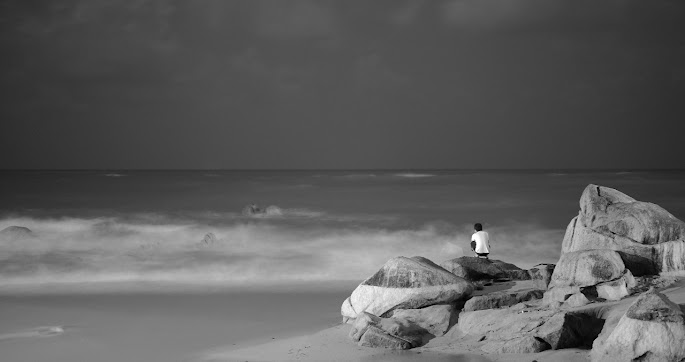
"Contemplating"
(a six seconds exposure at night at the beach, 50mm Summilux f/1.4 asph, ISO 200... the complete stranger on that rock sat still long enough...)
M9 color DNG turned red filtered monochrome DNG by DNGMonochrome.
(some additional post processing on this one)
Click on it for the 1280 pixel wide version.
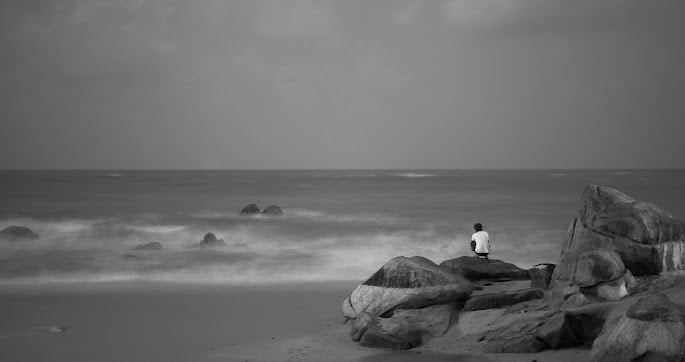
"Contemplating"
(a six seconds exposure at night at the beach, 50mm Summilux f/1.4 asph, ISO 200)
M9 color DNG turned blue filtered monochrome DNG by DNGMonochrome.
(some additional post processing on this one)
Because of the long exposure the sea becomes very fuzzy as opposed to the sharp rocks that don't move. The blue filter pulls the sky and the sea out, creating the strange illusion that the guy on the rocks is watching an out of focus movie (like the sea is projected onto a screen), or that the rocks and him were pasted on top of the photo... The red filtered one also creates that illusion, but less strong...
Click on it for the 1280 pixel wide version.
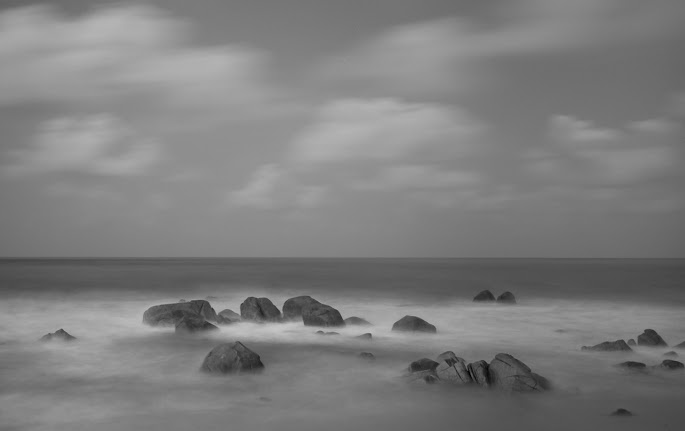
"Rocks"
(a 32 seconds exposure at night at the beach, 28mm Elmarit f/2.8 asph, ISO 200)
M9 color DNG turned blue filtered monochrome DNG by DNGMonochrome.
(some additional post processing on this one)
Click on it for the 1280 pixel wide version.
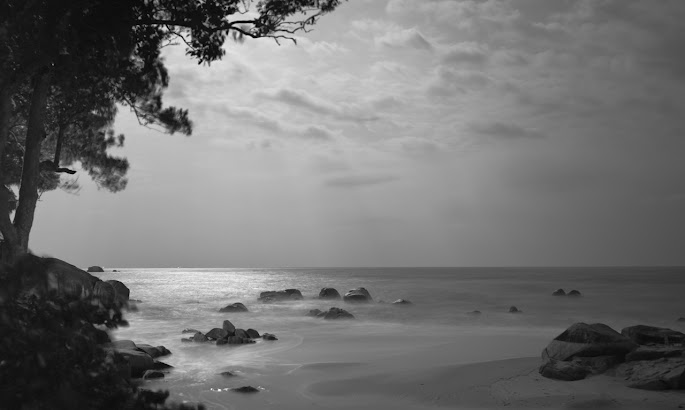
"Moonlit"
(an eight seconds exposure at night at the beach, 28mm Elmarit f/2.8 asph, ISO 500)
M9 color DNG turned blue filtered monochrome DNG by DNGMonochrome.
(some sharpening and noise reduction on this one)
Click on it for the 1280 pixel wide version.
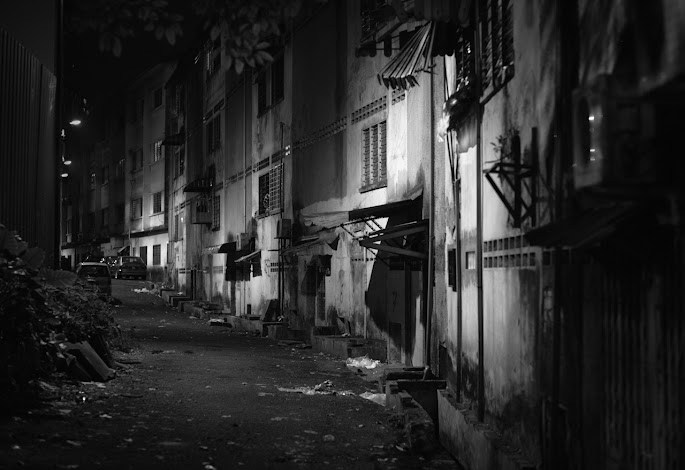
"Alley"
(1/30sec, Summilux 50mm f/1.4 asph, ISO 640)
M9 color DNG turned regular monochrome DNG by DNGMonochrome.
(no sharpening or noise reduction)
Click on it for the 1280 pixel wide version.
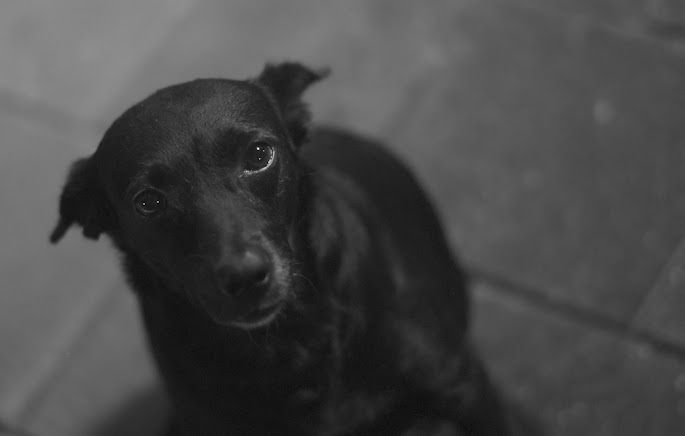
"Fatty Davis"
(1/15sec, Summilux 50mm f/1.4 asph, ISO 640)
M9 color DNG turned regular monochrome DNG by DNGMonochrome.
(sharpening and noise reduction applied, she really needed some TLC (and a cookie))...
Click on Fatty for the 1280 pixel wide version.
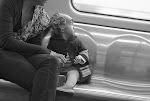

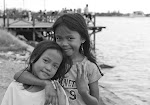
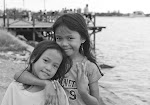
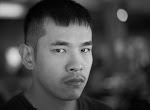
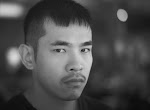


All the examples from the other parts... click on any of them for a 1280 pixel wide version... none of them have sharpening or noise reduction applied...
All the DNGs produced by DNGMonochrome were compared with output from Lightroom 3.6 and all JPGs were produced by importing the monochrome DNGs into Lightroom 3.6 and exporting them after additional post processing (some more than others). Despite my comparisons and sometimes condescending remarks about Lightroom, I like the program a lot and it treated my monochrome DNGs with full respect.
Special thanks to E. for listening to me rant about red, green and blue for weeks, and to Y. for the use of his portrait in this experiment...
---------------------------------------------------
The Assumption (from part I)
Creating a color photo out of a RAW file requires more processing than creating a monochrome photo out of the same RAW file.
The Idea (from part I)
If you turn a photo B&W in Lightroom, it's still based on the processed color photo. What happens if you use a lighter method to turn the RAW into monochrome? If you want monochrome, couldn't the interpolation be simpler, possibly leading to better results?
The Result
You be the judge after reading this series, looking at the photos and in the end - if you like - by trying the software.
The Method
I use the green values (the green filtered pixels on the sensor) or the red values (for a 'red filtered monochrome DNG') or the blue values (for a 'blue filtered monochrome DNG') to interpolate the photo. And to be able to do so, I implemented three algorithms, which I call Ratio I, Ratio II and Gradient (with 'Gradient' strongly based on the VNG algorithm, and Ratio I and II based on a more simple gradient principle with edge detection - all algorithms mixed with parts from ratio based approaches). I can also mix Ratio I or II with Gradient and use Gradient that way to prevent certain artifacts whilst retaining the sharper output.
I do not want to take credit for the algorithms, since the basic principles of the ones I use were thought up by other people... I just adapted.
Is this a new idea?
No... well, part of it isn't.
What isn't new about it is taking the luminance part of the color and using that to convert to black & white.
Several photo programs can do something like that by converting the RGB photo first to a different color model, Lab for instance (don't be discouraged if you don't understand one iota from what you read in that link, since that article was written by superNerd... he's known for his somewhat incoherent babble, bit like Heidegger... they speak great truths, but nobody knows it for sure...).
Then they use the L part of the Lab conversion to produce a monochrome photo (the L in Lab stands for Lightness and that's not the same as Luminance in the luminance / chrominance model, but lightness is calculated based on luminance, so they are related... ask superNerd if you don't believe me, but make sure you have time enough for his answer...).
But the basis of such a method is the RGB color photo.
At some point early in the chain, there had to be color interpolation (even if it's a JPG straight out of your camera, it was color interpolated - in the camera).
Then there's all kinds of options in Photoshop, where you can twiddle with the RGB channels and easily filter out parts of the RGB image.
I'm skipping the RGB result completely - no full color interpolation, just a little bit of it - and go straight to the L(uminance) via the green pixel values, cutting all kinds of corners. And that's the biggest difference of course, because to achieve that - avoiding the RGB result - I had to implement my own algorithms.
That might be new, I don't know if other nerds out there tried this before iNerd (that's me) tried it.
All the consequences of this method, compared to all kinds of other methods out there, I also don't know, because I have tried only a few (mainly in Lightroom version 3.6).
I am just interested in creating a monochrome DNG, hoping to end up with cleaner and sharper results (so far so good).
You might be able to achieve similar results with other methods. But if the assumption is that you can get sharper results by making the interpolation simpler, avoiding the heavy duty color interpolation algorithms seems almost mandatory. My recently failed detour with DNGRender seems to support that theory: the algorithm that works fine for monochrome, produces quite some problems when applied to create a color photo. So if you attack those color problems by toughening up the algorithm - or by applying additional steps afterwards - there's also the risk that you start losing detail.
And about the L part of this method, theoretically speaking: I'm not sure if I am even allowed to call the green pixels 'the L(uminance) part'.
Walking the Line
The color police might fine me, because the green pixels are the L part in a color model, but I don't produce a color photo!
That might already be walking the line - on the border of the color law - seeing how I render the Bayer filter useless - 'in a Leica for god sake!' I can already hear them curse...
But me calling the green pixels the 'L' part and not producing color with it... that might be too much for some trigger happy color cop.
So I'm not sure what - or how - to call them when the green pixels are used outside a color model ('green pixels' actually sounds fine to me).
Possibly new
What is new about this (I think) is the DNG conversion.
I don't know of any software that performs this trickery on the RAW data (which doesn't mean it isn't already out there). Also, although I use the M9 DNG, I could have just as easily chosen a Canon CR2 raw file. The principle stays the same.
I realize that my choice to convert to DNG might be confusing to some, because TIFF seems more appropriate (although essentially DNG is more or less an extended version of TIFF), but I had the urge to keep it within the DNG, mainly because it's easier to program for.
I do not consider these converted DNGs 'RAW files' anymore... It's difficult to say what they are exactly. They contain linear data and all the values stay within the RAW boundaries - and at least one channel represents sensor output - but I think a true RAW file should represent the total sensor output. And that is something they don't do.
The One Issue
Now, the FBM (Federal Bureau of Monochrome) might fine me for a completely different reason, because this method has one issue: it's entirely unclear what the monochrome conversion is actually showing you (tonal range, spectral sensitivity... or in simpler terms: what level of 'gray' should a particular shade of e.g. yellow get, compared to say a particular shade of e.g. purple in the same scene...)
The algorithm can be improved, I can make sure the output is artifact free (give me a few months and a lot of free time) but this issue - if you feel it's an issue for you - can not be resolved.
Also, don't ask me about the specifics of this issue, since I don't know what the spectral sensitivity is of the luminance part of the M9 sensor.
I'm just a guy who had an idea.
I don't have black & white eyes, nor a brain that can convert what I see to black & white. I also don't have any black & white film experience. I think this stuff can all be found out, by running clever comparisons between black & white cameras, black & white film types, and this method.
But I also have a life (sort of).
Then again, one could simply argue: this is M9 black & white film. If you don't like it, load her up with Lightroom B&W film, and you have more (fuzzy) choice.
So not bothered, ignorant and not limited by burdens from the past - taunting the color police and the Federal Bureau of Monochrome - I just muddle on with this piece of software.
And when the software is finished (at least in a first version), you can be the judge of your own DNGs. I designed it for my own benefit foremost (like M9Tether), I don't mind sharing and I like writing about it. If you read this series in full, you can draw your own conclusions.
Of course, for people coming from black & white film, this issue can not be brushed aside that easily, and I fully understand if they object to this method on the grounds of it being too different from the film look they might be after.
Be aware
Be aware though, that if you do try DNGMonochrome you know what you're doing, because me not caring about the objections of the authorities, doesn't mean I don't care about the quality of the overall result.
At least browse through these posts to get an understanding of the method. There are downsides if you use the wrong combination of algorithms for the purpose of the photo.
This method also isn't suitable for every photo and if you do discover artifacts I didn't catch, there's nobody to help you out.
One of the bigger issues for instance I haven't solved yet (and might never solve) is moire.
Moire
Faulty sensor data (basically the detail not being caught by a red, green and blue filtered pixel, but only by e.g. a green filtered and a blue filtered pixel, leading to the wrong color - happens on slanted or diagonal lines that are too thin to cover the full three colors of the sensor pixels), causes what we call moire in the color scene and something entirely different in the monochrome scene. I know it's moire, because I see it in the original color version, but on first sight, in the monochrome version, I didn't recognize it as such. It has a different characteristic compared to the color version.
Some really fancy algorithms are able to deal better with the faulty sensor data and produce less moire. There's also algorithms around to deal with moire afterwards (sort of cleaning up after the fact - a moire Dustbuster), but implementing those properly takes a lot of time (I haven't tried the 'moire' tool in Lightroom 4 yet, basically slipped my mind... kinda interesting to find out if it can tackle the monochrome 'moire'...)
Printing
I also don't know how these results will hold up in print. I don't print a lot and currently I don't even have a workable printer (they always break down on me). I wish that were different, because I'm very curious to find out how some of my results look on large prints.
This method needs to prove itself especially in large printing. In that sense all this requires more testing.
My own personal opinion
Am I gonna use DNGMonochrome?
For sure (and I already did, if you look at the examples), seeing that the increased resolution or sharpness and the lack of color noise seems a benefit.
Fatty Davis, shown in part VI, was one of the best examples.
It's also the only way for me to spot any shortcomings in the software.
Then again, I can hardly be called objective about this and I'm an amateur photographer... my demands or look at photos might be quite different from yours. So for what it's worth...
But I will keep testing, experimenting and I have a few more algorithms I'd like to give a try. Downside is that the more new stuff I implement, the more time consuming it becomes, because I have to compare all the results. My aim is to get to one algorithm, which can combine the current sharpness with less artifacts, to get rid of the mix overs. Next step will be to inspect the Gradient algorithm, to see if I can improve it for monochrome.
I don't convert many photos to B&W, because frankly I'm impressed by the Leica M9 color output and I like color, but I also like the possibility to have monochrome output, at least as an option to consider. Most of the examples shown at the beginning of this post I like better in color, but they were good photos to experiment with, especially to show what blue filtering can do.
Working with these DNGs I notice they are clean, tack sharp and seem to have a sort of 'quiet' quality I can not put properly into words. Perhaps it's the lack of underlying color, perhaps I'm not objective enough, perhaps... but who cares...
Use it if it suits you, don't use it if it doesn't.
If you do use it, feel free to contact me (preferably through the email on the download page) to let me know your results and if it works for you, especially if you decide to print some of your results really large.
Pros and Cons
Let me try to sum up the pros and cons, as objectively as possible:
positive
- sharper output
- cleaner output (no color noise)
- full blown monochrome DNG (fully editable in Lightroom and others)
- ability to go for full red or blue
negative
- spectral sensitivity is unclear (although it can be found out by comparing to other methods, other cameras and/or film, I can not change it if you don't like the current output)
- possible artifacts if you use the most dangerous settings
- possible artifacts I haven't spotted
- the method is untested in (large) printing
- you have to know what you're doing and get a bit of an understanding of the method
- you have to be careful with the results and inspect them more thoroughly than you might be used to, especially if you intend to go over a 100% in printing.
When can I try this?
In a few minutes, after you download and install it.
It is for PC / Windows, but if I get requests enough I might try to port it to OSX. Theoretically that should not be too difficult, but the user interface might be a little bit skinnier, since I'm foremost at home, as a programmer, in Windows.
The download page can be found here.
---------------------------------------------------
And let's not forget...
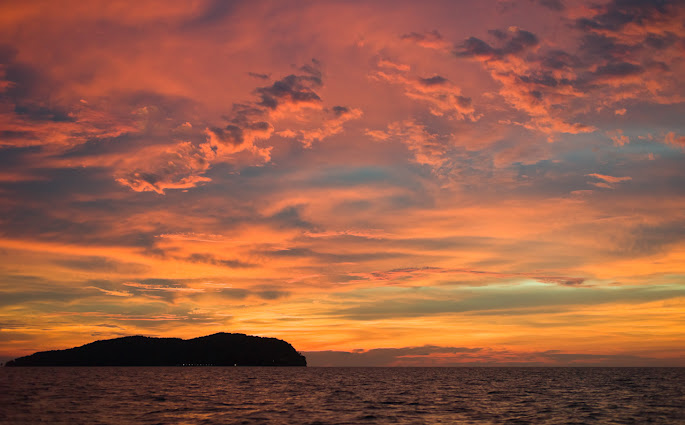 ...color is nice too...
...color is nice too...Kota Kinabalu, Sabah, Borneo, Malaysia, 1 May 2012
Click on photo for the full version... DNGMonochrome had nothing to do with this one...
The inspiration that led to the name 'Fatty Davis' for the dog...
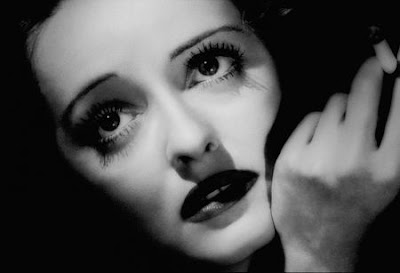
Stunning photo of Betty Davis...
Photographer unknown to me...
It was exactly this photo that leaped into my mind, leading to the name 'Fatty Davis' for the black (kinda fat) dog...
It's those eyes...
-------------------------------
"Stay on the road. Keep clear of the moors!" in part IV - line from 'An American Werewolf in London'
After seeing the results on this blog, Richard, from part VI, resigned from the color police and bought a Leica M9 so he can turn his color photos into monochrome.
The color police and the Federal Bureau of Monochrome do not really exist (I hope).
Labels:
DNGMonochrome
Subscribe to:
Comments (Atom)



